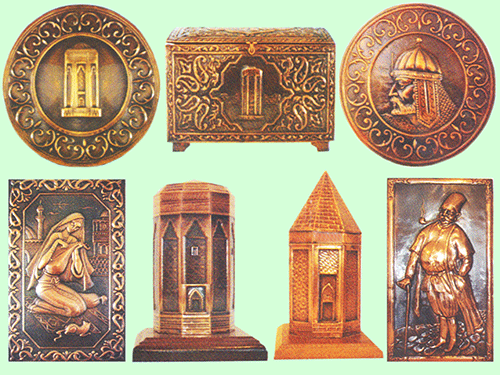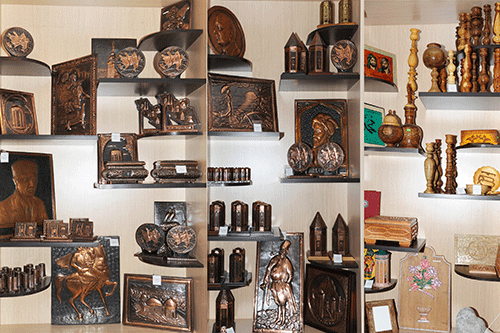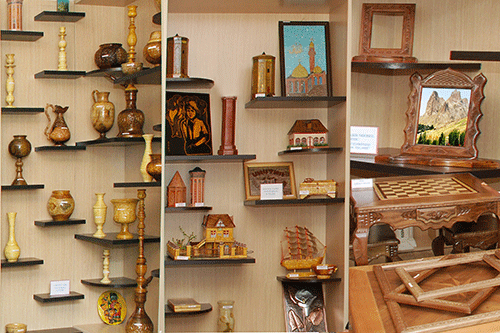Handicraft
 |
 |
 |
Pottery, metal processing, brazing, stone processing, wood processing, wearing, jeweler’s art and etc., being the ancient fields of popular art, are known since Eneolit and Initial Bronze Ages. Intensive development of tillage and cattle breeding in Nakhchivan created possibilities for evolution of handicraft. The growth of cultural necessity was completed with making of jewelry, artistic design of labor tools, mode of life equipment, definite parts of arms. As the result of archaeological excavations from the ancient dwelling places (I and II Kultapa, Sadarak, Nakhta, Ovchular’s Hill, Dasharkh, Gizilburun, Shahtakhti, Garabaglar, Kulus, Kolani, etc.) brought to light different labor tools and rich handicraft examples, ornament and mode of life things. Social life manner, religious-ideological outlook, belief and traditions of ancient tribes once living on the left bank of the Araz River found their reflection in handicraft of that period.
Colored clay crockery (during this period the culture of colored crockery developed in Nakhchivan differing from others with a lot of features), multi-colored decorations, also elegant jewelry goods being made from bronze and silver, golden decoration things, beads being made from different minerals, tender handicraft works being made from metal, wood, bone, clay and stone, small clay and stone statues being typical for the culture of Bronze Age, are the brightest proves to it. Pottery, being an important field of ancient handicraft, was created in the area of Nakhchivan in the IV millennium BC. Archaeological materials show that clay crockery belonging to Eneolit and Bronze Ages were prepared in a potter’s wheel and burned in special forges. The most ancient remainders of potter's forges were found in the living dweller of I Kultapa. From II Kultapa living dweller were found different-shaped colored kitchen utensils with simple, geometrical and botanic patterns, bird and animal pictures (big pitcher, jug, bowl, pail, vase, lamp etc.), being prepared by hand, partly in potter's wheel. Decorating, coloring, squeezing, etc. of pottery goods, distinguished with their quality, motley and high quality forms are important fields of the people’s art.
Nakhchivan is one of the first ancient metal-processing (copper) hearths of the world. From the most ancient cultural layers of I Kultapa dwelling place different tools and adornment examples with copper-arsenic, nickel-arsenic mixtures were found. Moreover, from Plovdag necropolis of Ordubad district a lot of bronze pins and from Kultapa four pins with buttonholed heads related to Bronze Age, a piece of a knife, etc. were found. Materials, being discovered as the result of archaeological excavations, indicate that the ancient inhabitants of Nakhchivan had mastery of making labor tools and adornments from bones and stones. Spindle heads made from stone, bone and clay, referring to trade of weaving, also very tender remainders of materials were met there. In the Middle Ages handicrafts as brazing, jeweler’s art, silkworm breeding, carpet making especially got a scope, different mode of life equipment and jeweler goods, being prepared with high mastery and taste, gained popularity. Those handicraft goods were exported to foreign markets, too. The master of art metal Osman ibn Salman Nakhchivani’s bronze can, decorated with carving patterns (1190), is being preserved in Louvr Museum (France).
Since the Middle Ages the technology of production was perfected, wheeled sweep coming into motion by legs (cocoon-opening loom) was used in silk production, agile weaving looms – in silk workshops. Ordubad was one of the main centers producing silk materials. Azerbaijan silk was exported to Iraq, Little Asia, Syria and different countries of Europe. Coarse calico production handicraft was widely spread in Julfa, Ordubad and Nakhchivan.In the Middle Ages carpet-making art was also developed, occupying an important place in life and economy of Nakhchivan population. Carpet-making traditions are carried on today as well.


